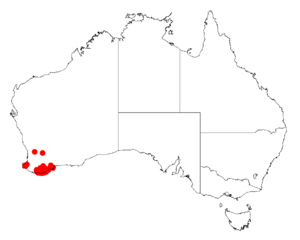Acacia luteola facts for kids
Quick facts for kids Acacia luteola |
|
|---|---|
| Scientific classification | |
| Genus: |
Acacia
|
| Species: |
luteola
|
 |
|
| Occurrence data from AVH | |
Acacia luteola is a type of shrub that belongs to the Acacia family. It is special because it grows naturally only in a specific part of southwest Australia. This means it is endemic to that area.
What Does Acacia luteola Look Like?
This shrub usually grows to be about 0.2 to 1 meter (or 0.6 to 3.3 feet) tall. Its small branches are covered in tiny hairs.
The leaves of Acacia luteola are quite interesting. They are made up of two or three pairs of smaller leaf parts called pinnae.
- The pinnae closer to the stem are about 2 to 5 millimeters long.
- The pinnae further out are about 3 to 12 millimeters long.
These pinnae often curve backward and have an oval shape.
Even smaller parts, called pinnules, make up the pinnae.
- The inner pinnae have two to three pairs of pinnules.
- The outer pinnae have two to five pairs of pinnules.
These pinnules are usually narrow and oblong, measuring about 2 to 6 millimeters long and 0.5 to 1 millimeter wide. They are green and often have edges that curl backward. Their tips are narrowed at an angle.
This plant blooms from February to November, showing off its creamy-yellow flowers. The flowers grow in simple groups, usually one at a time, in the spots where leaves meet the stem (called axils). These flower groups are round or cylinder-shaped and contain 16 to 30 flowers that are cream to pale yellow.
After flowering, the plant produces hairy seed pods. These pods are about 2 to 5 centimeters long and 4 to 6 millimeters wide. Inside, the seeds are arranged at an angle.
How Was Acacia luteola Named?
A botanist named Bruce Maslin first officially described this plant in 1975. He wrote about it in a scientific paper called Studies in the genus Acacia (Mimosaceae) - A Revision of Series Pulchellae. This paper was published in a journal called Nuytsia.
Later, in 2003, another scientist named Leslie Pedley changed its name to Racosperma luteolum. However, in 2006, it was moved back to the Acacia group, which is its current name.
The very first plant specimen used to describe the species (called the type specimen) was collected in 1922. It was found by Charles Austin Gardner in the Porongurup Range.
Where Does Acacia luteola Grow?
Acacia luteola is native to the South West and Great Southern parts of Western Australia. It often grows in low-lying areas.
Most of these plants are found in a region stretching from Mount Barker to the Stirling Range in the north. In the south, they grow down to areas near Albany and the Beaufort Inlet.
This shrub likes to grow in sandy, sandy clay, or loamy soils. You can often find it in seasonal swamps. It is part of the plant communities found in mallee or woodland areas.

